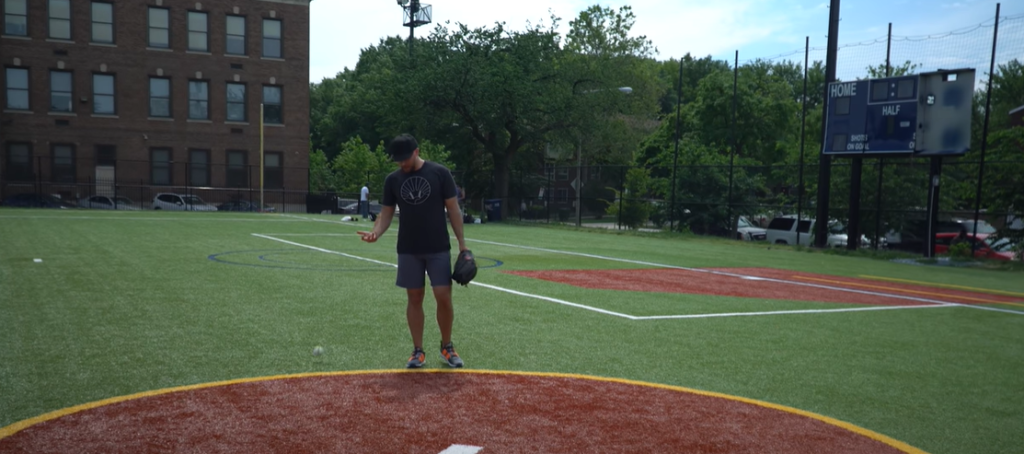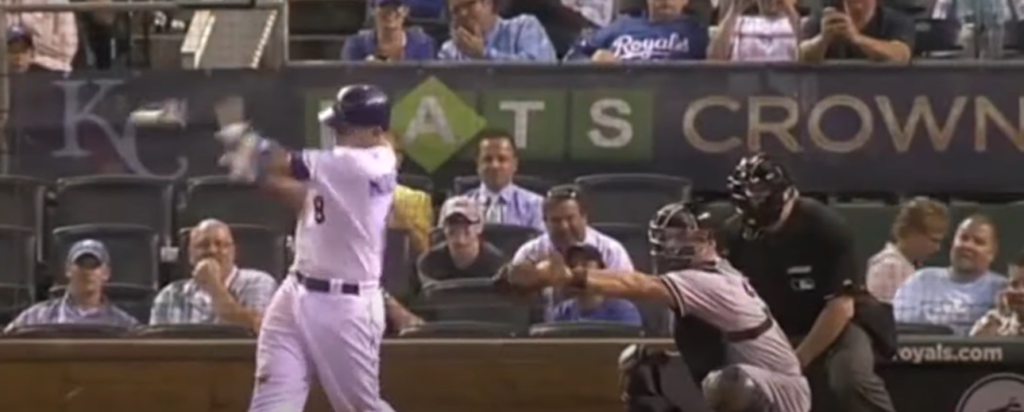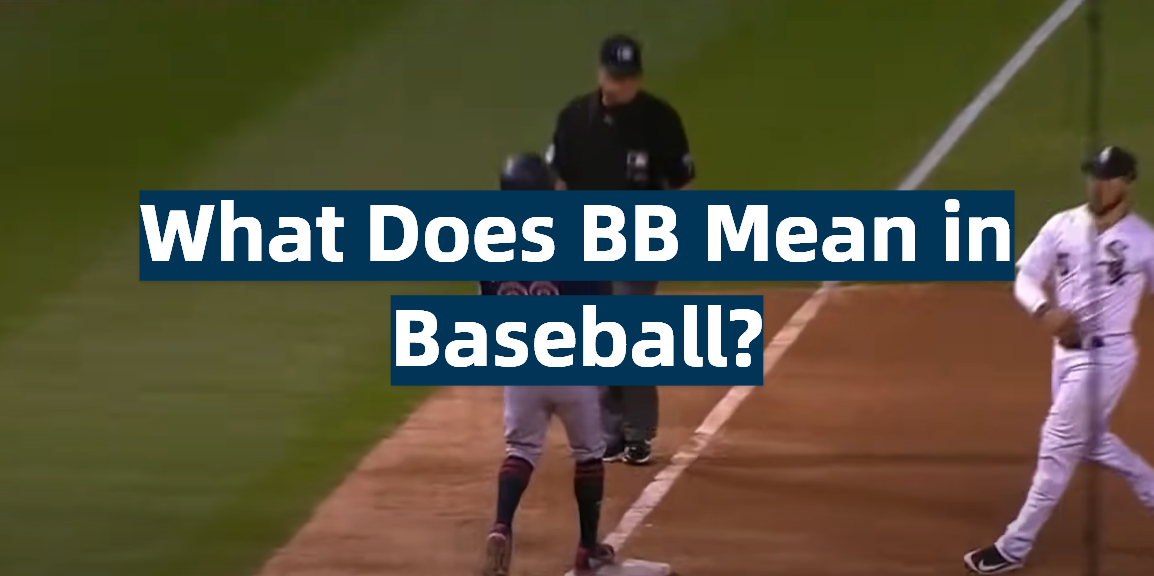If you’ve ever watched or even heard about baseball, you’ve probably heard the abbreviation BB thrown around. But do you know what it actually stands for? If not, don’t worry – there’s nothing to be embarrassed about! In this blog post, we’re going to explore exactly what BB means in baseball and uncover why it is so important in understanding the game. We’ll look at how statistics such as walks, hit by pitch and wild pitches factor into this common abbreviation while also exploring its other nuances so that ultimately by the end of the article you can become a pro on all things related to BB in baseball! So strap yourself in and let’s get started on unraveling the mysteries of the mighty three letters – “BB”!
BB in Baseball Meaning
BB is the abbreviation for Base on Balls, and it is one of the most common statistics in baseball. This statistic represents any time a batter is awarded first base without having to swing at the pitch. This can occur after four balls have been thrown outside of the strike zone, a wild pitch, or when a defensive player interferes with a batted ball. BB only applies to batters, and not all other players who may be on base due to walks, such as runners who are granted first base due to catcher’s interference.
In summary, BB stands for Base on Balls and refers to the statistic when a hitless pitch results in the batter being awarded first base without having to swing at the pitch. On the flip side, Out (O) means that a hitter swings at a pitch and puts it into play. Quickly, the fielder must catch or field the ball and hurl it to first base before the batter can arrive there. The opposite of BB is Out (O). [1]

Why Is BB Also Called a Walk?
In baseball, BB usually stands for a “base on balls” or “walk.” When a pitcher sends four balls outside of the strike zone that go untouched by the batter, this is known as a walk. Instead of having to hit the ball, the batter is then granted first base. Additionally, this occurrence can be referred to as an unintentional base on balls (BB), though less commonly known.
A walk is considered an offensive event, meaning it benefits the team at bat since they have obtained a runner without swinging their bat. Teams use walks strategically in order to advance runners into scoring position, or even score runs directly from a walk with bases loaded. Walks are also sometimes issued intentionally by pitchers in order to “give” the opposing team a base runner in exchange for an out.
In baseball statistics, BB is used to denote how many walks a pitcher or batter has. A high number of walks can indicate that either the pitcher is struggling with control or that the batter has good plate discipline and often takes pitches outside of the strike zone. Conversely, batters who swing at too many balls may be considered impatient and low walk counts could indicate this. [2]
How Does the BB Affect the Batter’s Performance?
The BB, or Base on Balls, can affect the batter’s performance in various ways. The most obvious benefit is that it increases a player’s on-base percentage and consequently the team’s overall offensive production. On-base percentage is an important statistic for evaluating players and teams, since it measures how often a player reaches base safely over the course of a game or season. As such, getting on base via a BB can be more valuable than other types of hits (such as fly balls) which may result in an out. In addition, getting on base via a BB does not count against the batter’s batting average.
Another advantage to being awarded with a BB is that it increases the chances of scoring runs. If a player is already on base, it only takes one hit to bring that runner home. Therefore, getting on first base via a BB can be an important step in the process of manufacturing runs.
Finally, being awarded with a BB allows the batter to have more control over his at-bats. This is because instead of having to swing at every pitch thrown by the pitcher, the batter can now wait for the perfect pitch and take it if he thinks it’s favorable or walk away if he doesn’t think he can get a hit out of it. [3]

What Is the Difference Between a Walk and a Hit-by-pitch?
A walk and a hit-by-pitch are two separate outcomes in baseball that are sometimes confused. A walk occurs when the pitcher throws four pitches outside of the strike zone, and the batter does not swing at any of them. This results in an automatic base for the batter and is recorded as a “BB” on the scorecard.
Of course, no matter what type of play it is — walk or hit-by-pitch — there is always an opportunity to advance further around the bases by stealing or tagging up on any fly ball. These plays are not recorded with BB or HBP, but rather with stolen bases (SB) or fly outs (F).
Which MLB Players Have Very High BB Scores?
Some of the most prolific MLB players in terms of draw walks are Barry Bonds, Rickey Henderson, Babe Ruth, and Ted Williams. From 2001 to 2004, Barry Bonds led all MLB players with a walk rate of 20.2 percent. His career on-base percentage stands at .444, which is the best ever recorded in baseball history. Rickey Henderson had an even higher career walk rate than Bonds – he averaged 19.9 percent over his 25 years in the major leagues and finished with an impressive on-base percentage of .401. Babe Ruth posted a lifetime walk rate of 17.3 percent and an on-base percentage of .474 while Ted Williams ended his career with a 16.7 percent walk rate and a whopping .482 lifetime on-base percentage.
Other great players who have achieved high Walk scores include Frank Thomas, Albert Pujols, and Mike Schmidt. These three players each had walk rates over 15 percent in their careers – Thomas at 16.1 percent, Pujols at 14.9 percent, and Schmidt at 15.3 percent – and all ended with an on-base percentage of over the .400 mark. All these players are remarkable not only for their ability to draw walks but also for the longevity of their performance – each one of them played in the major leagues for more than a decade and proved that a good eye is an essential tool for any successful hitter.
Other Baseball Abbreviations
In addition to BB for a “walk” or base on balls, there are other common abbreviations used in baseball. RBI stands for Run Batted In and is earned when a batter advances another runner around all of the bases.

A K refers to a strikeout, where the pitcher throws three strikes and the batter fails to hit the ball.
HR means home run — when a batter hits the ball over the outfield fence without assistance from any other player, thereby allowing them to circle all of the bases and score.
BB/9 stands for walks per nine innings which shows how many walks per game an individual pitcher allows throughout nine innings of play.
OBP stands for On-Base Percentage, which measures how often a player gets on base compared to their total number of plate appearances.
OPS stands for On-Base Plus Slugging and is a measure that combines a player’s on-base percentage plus their slugging percentage, which can be used to determine a player’s overall offensive production.
Finally, WHIP stands for Walks + Hits per Inning Pitched and is the average number of baserunners allowed by a pitcher in each inning they pitch. This metric can help indicate how effective or successful a pitcher has been over a period of time. [4]
Are There 7 Or 9 Innings In Baseball?
In baseball, there are nine innings in a game. After one team has completed batting in their half of the inning, it is then the opposing team’s turn to bat and attempt to match or exceed the runs scored by the first team in that inning. Once all nine innings have been played, the score between both teams is tallied and whichever has the most runs at that point is declared the winner.
Some leagues may play additional innings if needed in order to determine a winner. However, seven-inning games can be used for faster-paced tournaments or when time constraints are present.
Each inning consists of two halves with each team taking turns batting, starting with the visiting team before switching over to the home team after they have completed their at bats. The game is concluded when the home team has completed their offensive turn in the bottom of the ninth inning, or taken an earlier lead that cannot be matched by their opponents.
No matter how many innings are played, baseball remains an exciting and strategic sport with plenty of opportunities for a winning team to emerge victorious. Knowing the abbreviations and understanding the rules of the game can help you better understand and appreciate this classic pastime.
Tips on Playing Baseball with BB
Playing baseball with a BB is fun and challenging, especially if you’re new to the game. Here are some tips to help make your experience playing with a BB enjoyable:
- Wear safety gear – Just like any other sport, it’s important to wear the proper safety gear when playing baseball with a BB. This includes eye protection (goggles or face masks), gloves, and long-sleeved shirts and pants.
- Warm up before playing – You should always stretch out your muscles before playing any sport, including baseball with a BB. Doing so helps prevent injury and prepares your body for the physical activity ahead.
- Practice accuracy – When using a BB in baseball, accuracy is key. Take the time to practice hitting the ball at different angles and distances to build your accuracy.
- Stay alert – When playing baseball with a BB, it’s important to remain aware of your surroundings and other players on the field. This will help you avoid collisions and possibly dangerous situations.
- Have fun – Above all else, remember that playing baseball with a BB should be enjoyable! So take the time to enjoy yourself while still taking safety precautions seriously.
By following these tips, you’ll be able to play baseball with a BB safely and have an enjoyable experience doing so! [5]

Benefits and Cons of Playing Baseball
Baseball is an exciting and rewarding sport to play, but like any physical activity it also has certain risks associated with it. Knowing the benefits and cons of playing baseball will help you make an informed decision about whether or not to take part in the game.
The Benefits of Baseball:
- Playing baseball can be a great way to stay fit and healthy. It is an excellent form of exercise that combines fast-paced movements with strength training, helping players stay in shape while having fun at the same time.
- Baseball also provides opportunities for learning new skills and improving existing ones. From honing hand-eye coordination to developing better technique, playing baseball can give players a chance to hone their skills and become more proficient in their sport.
- Baseball also helps to develop social skills, as it is typically played in teams. This allows for players to interact with one another and build strong relationships.
The Cons of Baseball:
- Playing baseball can be hard on the body due to its physical nature. It requires a lot of running, jumping, throwing, and catching which can lead to injuries if proper form isn’t used or if the player is not in peak physical condition.
- Another drawback of baseball is that it takes time and dedication to become proficient at the game. Players need to practice regularly in order to stay sharp and improve their skill level.
- Finally, playing baseball may require substantial investments of time and money. Purchasing uniforms, bats, balls, and other equipment can be costly for teams or individuals. Additionally, participating in tournaments or leagues may require additional fees.
By understanding the benefits and cons of playing baseball, you can make an informed decision about whether or not to participate in the sport. Whether you are a beginner or an experienced player, knowing what you’re getting into is important for any type of physical activity. With some dedication and practice, anyone can become a proficient baseball player and reap the rewards that come with it!
FAQ
Does a BB count as a base?
Yes, a BB (base on balls) counts as a base in baseball. When a pitcher throws four balls to a hitter, the batter is awarded first base. This occurs when the umpire determines that the pitcher cannot throw any strikes, regardless of whether or not the batter swings at them. The hitter can now take their position at first and receive credit for advancing one base without having to actually hit the ball with their bat. A BB is also known as “a walk” and it’s an important part of many players’ offensive strategy. Although obtaining a walk won’t result in an RBI (run batted in), it still increases their chances of scoring if they are able to get past first base safely.

Is a BB good in baseball?
Yes, a BB is good in baseball as it can lead to runs being scored. A player that walks often is seen as disciplined and patient at the plate, which are both traits desired by teams. Additionally, walking puts less strain on a hitter’s body than swinging away and allows them to maximize their playing time.
What is the H in baseball?
The H in baseball stands for “hits”. A hit is a successful attempt to make contact with the ball and get it past the infielders. Getting a hit increases your chances of advancing around the bases, or even scoring a run. There are different types of hits including singles, doubles, triples, and home runs. Hits can be counted as RBIs (runs batted in) depending on whether there are other runners on base at the time.
What does G mean in baseball?
G stands for “games” in baseball. It is used to describe the number of games a player has played in a season, or the total amount of games their team has won or lost. For example, if a team has a record of 30-20, then they have won 30 games and lost 20. A G can also refer to an individual game that is taking place at a given time.
What is an R in baseball?
An R in baseball stands for “runs”, which is a score that a team earns when one of its players crosses the plate. Players can score runs by hitting a home run, getting a hit and advancing around the bases, or even walking (BB). The team with the most runs at the end of an inning or game is usually declared the winner.
What does F7 mean in baseball?
F7 stands for “fly out to left field” in baseball. It’s a notation used by scorers to indicate how an out was made on the field. It indicates that the batter hit a fly ball that was caught by a fielder in left field and is now out. Other notations include F8 (fly out to centerfield) and F9 (fly out to right field).
Useful Video: What does BB mean in baseball?
Conclusion
In conclusion, BB is a commonly used acronym that stands for “Base on Balls” in baseball. It is usually used when referring to the number of walks given by a pitcher during a game or a player’s total walks during their career. Knowing what BB means will help you better understand the conversations and statistics of baseball fans, as well as give you an insider knowledge of the sport. So the next time someone mentions “BB” or “walks,” you’ll know they are talking about Base on Balls in baseball!
References:
- https://wezen-ball.com/what-does-bb-mean-in-baseball/
- https://en.wikipedia.org/wiki/Base_on_balls
- https://www.sportskeeda.com/baseball/news-mlb-stats-what-does-bb-mean-baseball
- https://baseballxgear.com/baseball-stats-abbreviations-what-do-they-mean
- https://abbreviations.yourdictionary.com/articles/basic-baseball-stats-abbreviations.html










Leave a Review